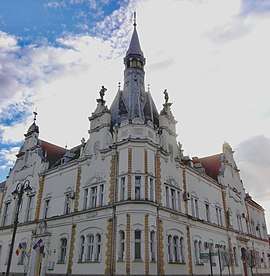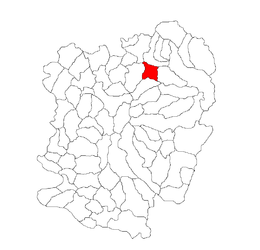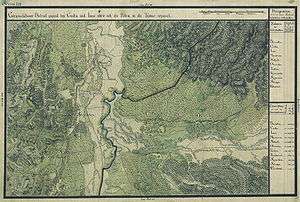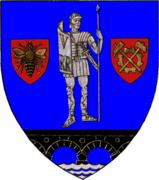Caransebeș
Caransebeș (Romanian pronunciation: [karanˈsebeʃ] (![]()
Caransebeș | |
|---|---|
 Caransebeș Town Hall | |
 Coat of arms | |
 Location in Caraș-Severin County | |
 Caransebeș Location in Romania | |
| Coordinates: 45°25′17″N 22°13′19″E | |
| Country | |
| County | Caraș-Severin |
| Government | |
| • Mayor | Felix Borcean[1] (PNL) |
| Area | 70.08 km2 (27.06 sq mi) |
| Population (2011)[2] | 24,689 |
| • Density | 350/km2 (910/sq mi) |
| Time zone | EET/EEST (UTC+2/+3) |
| Vehicle reg. | CS |
| Website | www |
One village, Jupa (Hungarian: Zsuppa), is administered by the city.
Geography
Climate
The climate in Caransebeș is rather mild. Sub-Mediterranean climatic influences are present to some extent. Temperatures do not drop too low in winter (with an average of 0,-15 °C), but summers can be warm (30-38 °C average). Rainfall can be quite abundant throughout the year.
History

The first traces of habitation here might date as far as Dacian times. Dacian ruins have been discovered recently near Obreja, a village 7 km away. As the Romans invaded Dacia, they built a castrum named Tibiscum, which was dug up by archaeologists near the nearby village of Jupa, a castrum which later grew to be a full city. Tibiscum is considered one of the gates of Christianity in Dacia, having an important role also in the Romanization of the local people.
During the Middle Ages, the local people continuously inhabited the area. The region became part of the Hungarian Kingdom, then later under the rule of the Transylvanian Principality, and under the rule of the Ottoman Empire. In 1787 a self-inflicted defeat, the Battle of Caransebeș, is supposed (the historical accuracy is in doubt) to have taken place here. Later, the Habsburgs took the control of the region, after prolonged wars against the Ottomans. As part of the Principality of Transylvania, in 1804 it became part of the Austrian Empire. After the Austro-Hungarian Compromise of 1867, it became again part of Hungary.
After railroads began to appear, the role of Caransebeș grew continuously. In the late 19th century, the Romanian people of the settlement elected to the Parliament of Hungary the Hungarian Lajos Mocsáry, who was a progressive democratic politician fighting for the cultural and administrative rights of all nationalities (including the Romanians) living in the Hungarian Kingdom of that time. After the Treaty of Trianon, in 1920 Caransebeș became part of Greater Romania. After the rise of the communist regime in 1947, an airport and an airbase were built close to the city. However, the airport did not remain operational for long after the 1989 Revolution.
Demographics
| Year | Pop. | ±% |
|---|---|---|
| 1912 | 7,999 | — |
| 1930 | 8,704 | +8.8% |
| 1948 | 10,106 | +16.1% |
| 1956 | 15,195 | +50.4% |
| 1966 | 18,194 | +19.7% |
| 1977 | 27,190 | +49.4% |
| 1992 | 31,985 | +17.6% |
| 2002 | 31,199 | −2.5% |
| 2011 | 21,932 | −29.7% |
| Source: Census data | ||
As of 2011 Caransebeș had a population of 21,932, mainly Romanians (93.48%), with Ukrainian (1.56%), German (1.17%) and Hungarian (0.78%) minorities present, but in decline.
Notable people
- Nicolae Corneanu, Orthodox metropolitan bishop
- Corneliu Dragalina, Romanian World War II General
- Ion Dragalina, Romanian World War I General
- René Fülöp-Miller, Austrian cultural historian and writer
- Sorin Grindeanu, politician, Prime Minister of Romania
- Emanoil Ionescu, Romanian World War II General
- Gustav Jaumann, Austrian physicist (1863–1924)
- Wilhelm Klein, archaeologist
- Patricia Maria Țig, tennis player
References
- "Results of the 2016 local elections". Central Electoral Bureau. Retrieved 3 April 2020.
- "Populaţia stabilă pe judeţe, municipii, oraşe şi localităti componenete la RPL_2011" (in Romanian). National Institute of Statistics. Retrieved 4 February 2014.
External links
| Wikimedia Commons has media related to Caransebeș. |
- (in Romanian) Official Website of the Caransebeș City Hall
- (in Romanian) Unofficial website about Caransebeș
- (in Romanian) Banaterra - Information about the Caransebeș Region
